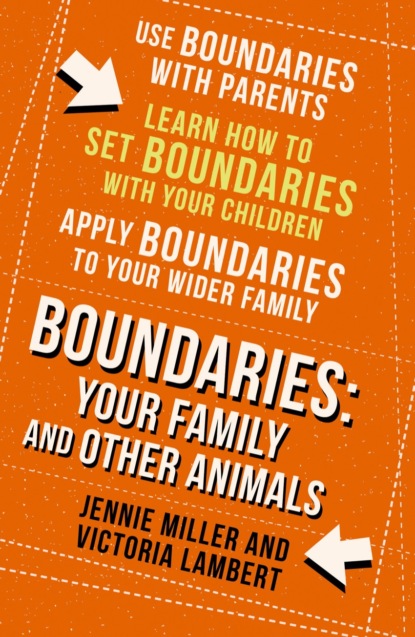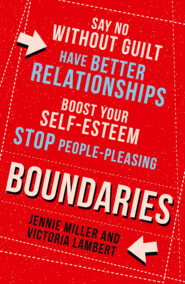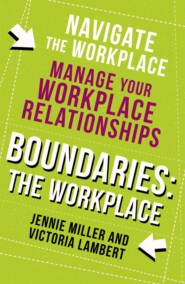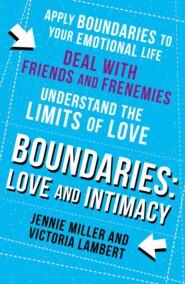По всем вопросам обращайтесь на: info@litportal.ru
(©) 2003-2024.
✖
Boundaries: Step Four: Your Family and other Animals
Настройки чтения
Размер шрифта
Высота строк
Поля
For example, our fast-paced lives require us to make more decisions than in the past, often quickly – yet with potentially serious consequences. The challenges to our boundaries are more complex and demanding, and we all need new strategies on how to live life as healthily as possible.
The effect of technology on our boundaries is particularly important when it comes to conversations and relationships. These used to be straightforward but now are more difficult because of the lack of face-to-face contact. Situations can easily be misread, moods can be misinterpreted and remarks can be misconstrued when you remove the physical presence of human contact.
The 24/7 culture of e-mails and the Internet means we can never switch off. We are no longer able to pull up the mental drawbridge – we are always vulnerable to what feels like outside pressures and invasions. Some of this attention is not unwelcome, we encourage it ourselves. But that doesn’t mean our boundaries are healthy; it may mean we don’t recognise what can hurt us.
The inspiration for this book came about through a conversation we shared on the subject of e-mail communication. In a steamy coffee shop full of post-school run parents and busy workers grabbing a latte to go, we found ourselves catching up on life, work, family and friends. During our chat, Victoria mentioned a familiar dilemma she was struggling with – she had been asked to help with a function which she had neither the time, energy, or the desire to do. However, she felt a strong pull to be useful and the resulting emotion was guilt. Jennie identified her problem as being a lack of boundaries and explained the concepts that underpin them (as we will explore in this book).
Victoria went home inspired and wrote an e-mail explaining to a colleague why she couldn’t help at the function. She wrote:
‘I am so sorry to say that I feel I cannot help with your plans towards putting on this event. I am really busy with work and childcare at the moment, so am finding it hard to make time. Obviously, I will still do what I can to be useful, and don’t forget to ask me to invite those people we mentioned, but I think that will have to be my input for now. Do call if I can do anything else.’
Then she thought again about Jennie’s explanation of boundaries, and realised she wasn’t being honest. Moreover, she was soft-soaping her decision because she felt guilty – which was confusing the issue, not clarifying it. Several long phone calls with Jennie followed as Victoria was feeling uncomfortable and anxious about the potential response. Jennie encouraged her to be brave and brief.
This was her second draft (with self-boundary): ‘I won’t be available to help with your event. I know it will be a huge success, and wish you well.’
And the response to that second e-mail: ‘Fair enough. Thank you for letting me know. Do come if you can.’
What Victoria found was that waiting for a response to a boundaried e-mail can feel nail-biting. However, as can be seen from the reply, others usually respond surprisingly well to a clear and no-nonsense message.
Think back to the last time you received a clear, concise e-mail. Wasn’t it refreshing and easier to engage with?
You need to know that your boundaries are in your control. You have the ability to decide when and how to draw the line in your life. This will be one of the most empowering lessons you ever learn.
How to Picture a Boundary
Depending on your personality and outlook, you may think of a boundary as an encircling brick wall or perhaps a fresh-looking picket fence with a gate always propped open, but we’d like to invite you to also think of your personal boundary in quite a different way.
Consider human skin. It’s dense enough to protect and contain us, but flexible enough to allow for movement. Skin is porous in the upper layers so what’s necessary can pass through – sweat can be excreted and sunshine absorbed to help us make vitamin D. Skin is also sufficiently tough to withstand accidental damage, and it’s capable of amazing re-growth.
As with skin, we can feel discomfort – even temporary pain at times – when boundaries get damaged either internally or from the outside when we don’t take care. Yet, again like our skin, boundaries are amazing because they can grow with us.
Why have we chosen to use skin as a metaphor? Because skin keeps us in contact with others – it’s not a brick wall or other type of opaque barrier. Studies show that skin-to-skin contact is actually vital for humans. Think of the studies which have shown that ‘kangaroo care’ – the nestling of a naked newborn on its parents’ bare chests – improves outcomes in premature baby care. And equally our skin can act as an early warning system for our entire bodies. Think of how your skin prickles when another person gets too close – it’s a very physical sensation.
Now, let’s look at your own personal boundaries.
EXERCISE: Your Personal Boundary
You will need another person to do this exercise with you. This other should be a friend or colleague but not someone with whom you are very close. We understand this may not feel easy, and you would be more comfortable with someone more familiar to you. But in close relationships, boundaries will be well established. We need you to step outside your comfort zone in order to experience a fresh boundary.
Begin by standing facing each other a comfortable distance apart – this might be four foot away from each other, or more or less.
You are going to stay on your spot. Notice the distance that feels comfortable. Now ask your exercise partner to step closer. They are now in charge of their movements and are gradually going to take one step at a time towards you, pausing for 30 seconds between each step. In that pause, consider how comfortable you feel.
As they come closer, note when you start to feel some level of discomfort. And when do you notice you are really not happy, and that your skin is starting to throw up a few goosebumps? When do you want to scream ‘stop’ – because your personal space now feels properly invaded? At that point ask your partner to step back.
So, what just happened?
This is your body unconsciously registering where it feels most comfortable in relation to another person. This is your discernible physical boundary. Bear this in mind as you read through the book – who oversteps this boundary and who stays too far away?
We suggest you have a notebook to hand while you go through the book so you can write down your experience of exercises like this and ideas that you want to make a note of so you can build up your own Learning Journal as you work through the book.
Part of understanding how to use boundaries is learning to look at interpersonal relationships and your own part in them. Then, deciding where and how to establish a boundary doesn’t just get easier, it becomes self-evident. The exercise above is your first step towards this.
Developing confidence in your own decision-making and its effect on your behaviour will make you happier as it means you are properly owning and taking care of yourself. In our experience: boundaries can give peace of mind. Boundaries give freedom. Boundaries are bliss.
STEP FOUR: YOUR FAMILY AND OTHER ANIMALS (#ulink_15503c92-c52a-59ca-9c6a-96e56ba06582)
‘Family not only need to consist of merely those whom we share blood, but also for those whom we’d give blood.’
CHARLES DICKENS
Our common fantasy family life draws on inspiration from those loving, yet chaotic groups in fiction like The Waltons, Modern Family, or even The Munsters. Who doesn’t hark occasionally back to life in Happy Days? Reality is rarely that simple though.
In Step Four, we are going to look at family members in four sections: Parents/Elders; Children; Adolescents; and Siblings and Blended Families. You may find it helpful to start with the Parents section, even if your most obvious point of conflict is with a child or brother, as many of our patterns begin with ‘Mum’ and ‘Dad’.
A family group needs boundaries just like the relationships we create through work or romance. But families come with some relationships ready-made – i.e. the one between your parents, that between siblings, etc. And they come with attitudes that have an impact which may be beyond anyone’s control. Plus, the stakes can be higher, thanks to cultural pressures.
The trouble with this fantasy idea – the dream of the perfect family as a necessary goal for everyone – is that it affects your ability to build the very boundaries which could make it more real. Our need for a fantasy family weakens our ability to create a real one.
And it can feel artificial to control your boundaries with your family rather than letting them evolve ‘naturally’, but healthy boundaries will take you much closer to your dream of a happy family than relying on past behaviour or hoping for the best.
Families are not natural organisms that will automatically develop into the best shape for all participants. The family as we know it is very much an artificial construct based around tradition, fiction and masses of hope. So, at any point be aware that your biology does not need you to be in a family unit. It is just as ‘natural’ to be independent from some or all of your family as it is to be that nuclear image of the Modern Family, where everyone gets along somehow and meets for lunch on high days and holidays.
What we will do in this step is explore how boundaries can improve relationships between family members – whether you choose to stay in a large Waltons-type community, a 2+2, prefer a more solitary experience with occasional Christmas cards and FB postings, or complete self-sequestration. Understand that it is OK to live any way and boundaries will help you achieve this.
Let’s stop and think how difficult this will be. We know boundaries in families may be the most awkward to tackle; that’s why we’ve left them until you’ve had a bit of practice on yourself and less established relationships first.
Hopefully you will be more boundary-fit, having learnt a few skills and developed them in a more neutral setting. Take a moment to think of an occasion when you have used a boundary (or even just thought of one) since you began reading this step. Make a note of it in your Learning Journal.
Note that you are still reading this book. Well done on having a clear desire to address your boundaries, even if that desire is a very quiet or indeterminate voice at present. We’re not expecting all readers to be boundary-ready at once; you may not even see the full benefit for some months after you put this book down.
Parents/Elders (#ulink_4c2a0d16-47bf-52af-bf3b-dbb0613ce046)
What we all aim for is to deliver as parents – or to receive as children – is a ‘good enough’ experience.
Why just ‘good enough’? Let’s all mentally pick up a picture of the most famous happy family we can think of – whether that is the Dunphys in Modern Family, the Brockmans in Outnumbered, or the Ingalls family in Little House on the Prairie. Now rip that picture up. No family is perfect; let’s take off the pressure. From this moment on, there is nothing to live up to; you decide the family you want to be part of.
Draw the Line:ditch your preconceptions about what should be: let’s enjoy what is and what can be. That’s what we mean by ‘good enough’.
This process will highlight what isn’t good enough for you and your family and what can be done about that. Let’s go forward from here.
EXERCISE: Draw Up Your Family
We’re going to divide parents/elders (which includes grandparents, adoptive or foster parents, or any significant older person who played that type of role in your life) into three broad categories:
• Mr and Mrs Pedestal,
• Mr and Mrs Nightmare (‘Oversteppers’ and ‘Ghosts’),









